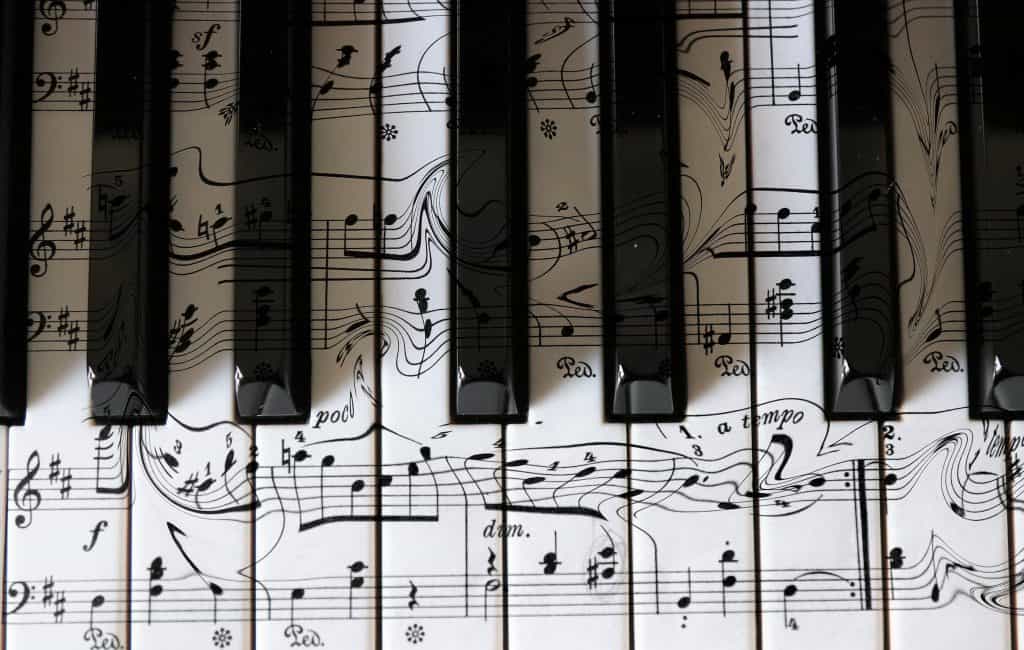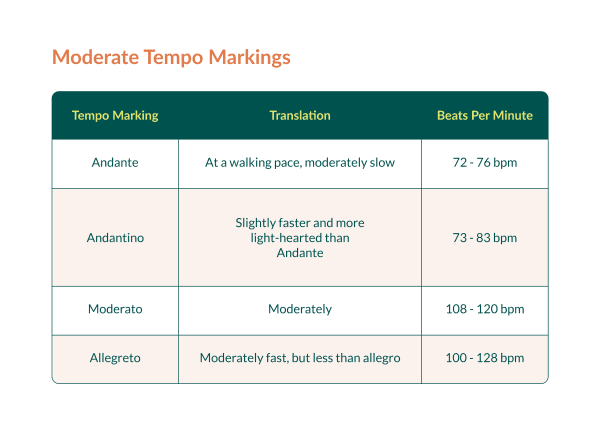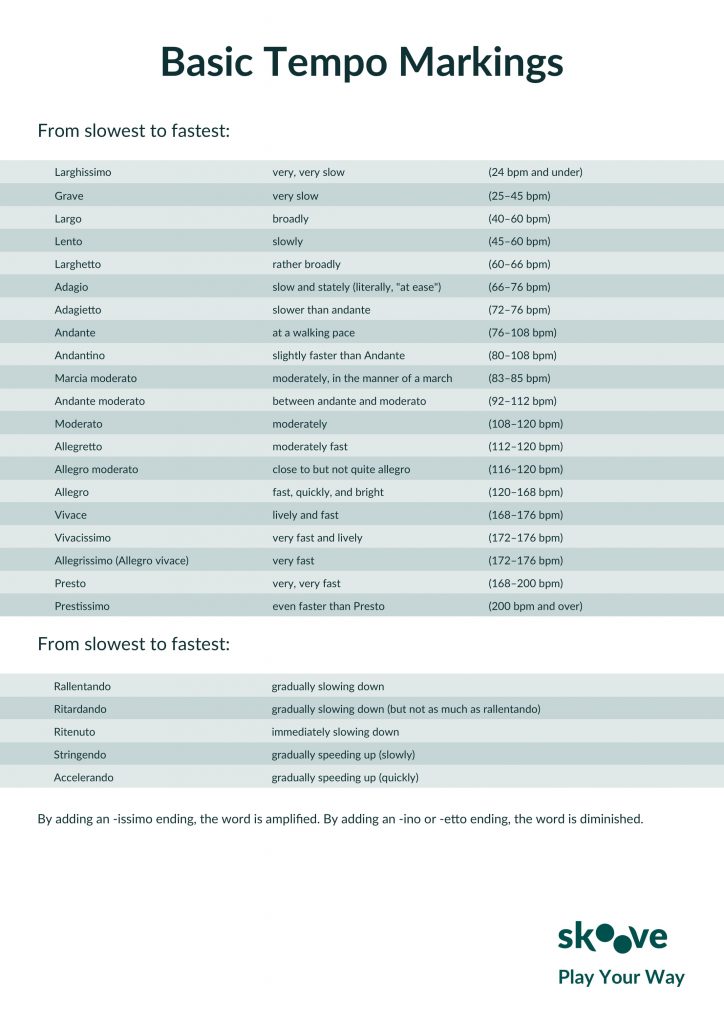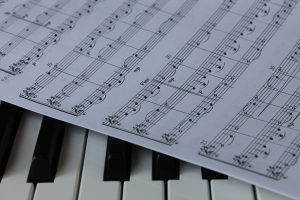In music, tempo markings such as allegro, andante, and moderato, typically located at the beginning of a score, are crucial for determining the piece’s speed. These terms, integral to musical notation, indicate both the original tempo and any changes throughout the composition.
Historically, tempo markings were used to denote specific dance styles or as titles, but their role has evolved to become a fundamental aspect of musical expression and interpretation. This article delves into a range of tempo markings, from the common to the less familiar, offering insights that enhance both the performance and appreciation of music.

What is tempo in music?
Tempo, a crucial term in music, refers to the speed or pace at which a composition is played. An allegro tempo signifies a brisk and lively speed, whereas an andante tempo implies a more leisurely, walking pace. Moderato tempo, on the other hand, strikes a balance, offering a moderate speed. These tempo markings guide musicians in adjusting the speed of their performance, much like time signatures direct the rhythms to be played.
While Italian tempo markings are predominantly used, tempo in music can also be denoted in other languages, including German. Sometimes, these common tempo markings are paired with bpm (beats per minute) in English, providing both a traditional tempo indication and a practical English reference. Regardless of the tempo, musicians need to maintain the articulation in music, ensuring the piece’s character and style are faithfully conveyed.
Why is tempo important in music?
The concept of tempo in music is essential, as it determines the pace at which a piece is played. Grasping tempo in music is crucial for understanding the emotional and stylistic elements of a composition. Consider the intro to “Bohemian Rhapsody” which is characterized by an andante tempo, imparting a slow, dramatic feel. If this section were performed in an allegro tempo, it would completely transform the piece’s essence, demonstrating the importance of tempo markings in music. Recognizing different tempo markings, such as andante, moderato, and allegro, is a fundamental part of music words. Without this knowledge, the intricate and dynamic aspects of musical expressions would be lost, highlighting why tempo in music is a key element in understanding and appreciating music.
View this post on Instagram
Tempo markings in music
There are many different tempo markings in music. We will learn about the most common music terms for tempo first. Most of these Italian tempo markings can be found on the online metronome and can also be found at the beginning of any piece of music above the key signature on the top left side. Here are some common examples of music tempo markings.
Slow tempo markings
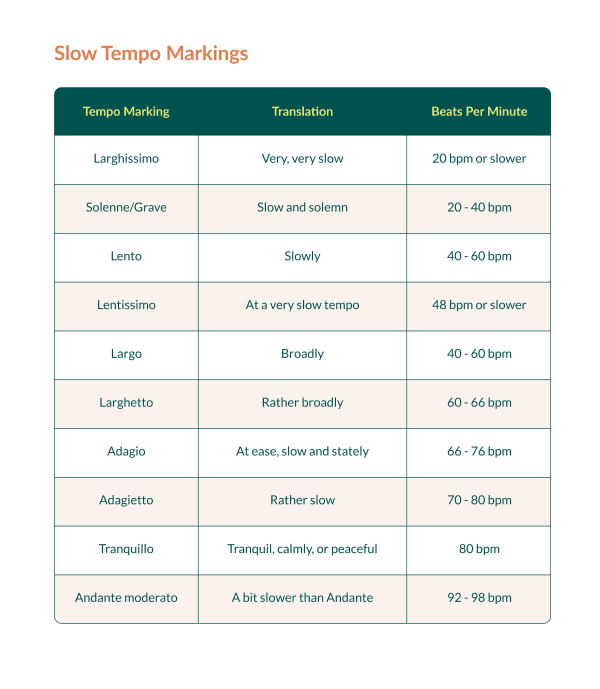
- Grave – Grave (GRAH-vay) is a very slow and solemn tempo between 25-45 beats per minute (bpm). Here is an example of a grave in music:
- Lento/Largo –Lento and largo are two music terms for tempo that mean slowly. Largo is generally thought of as more “broadly” while lento is more “slow”, but they are often used interchangeably to mean a speed between 40-60 bpm. Here is an example of largo in music:
- Adagio –Adagio means “at ease.” Adagio is a tempo marking in music that means gentle and easy and is not too slow or too fast. Adagio generally falls between 66-76 bpm. Here is an example of adagio:
Moderate tempo markings
- Andante –The term andante means walking speed or a walking pace. Andante is a tempo between 76 and 108 bpm. Here is an example of andante in music:
- Moderato –Moderato means moderately and is associated with speeds from 108-120 bpm on the metronome. Here is an example of moderato in music:
Fast tempo markings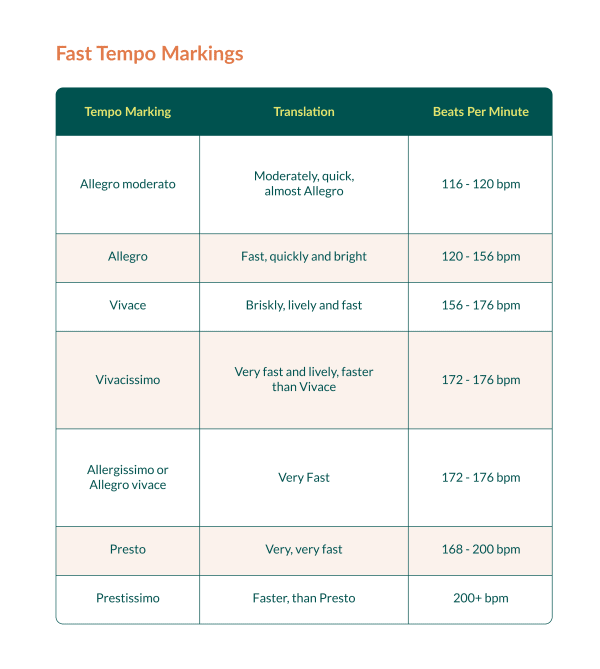
- Allegro – Allegro is thought of as fast, quick, and bright. Think of a sparrow flying in spring or a rock skipping across to water. Allegro includes a wider range on the metronome than the other Italian tempo markings so far. Generally tempos from 120-168 bpm are considered allegro. Here is an example of allegro in music:
- Vivace –Vivace is a step above allegro. Vivace is also light and fast, ranging from 168-176 bpm on the metronome. Have you ever seen a cafe called something like “Vivace” or “Espresso Vivace”? That sort of zippy, caffeinated feeling accurately captures the tempo of vivace.
- Presto –The final Italian tempo marking we will dive into here is called presto. Presto is extremely fast and light. Anything above 170 bpm can be called presto. Having proper piano technique is critical to playing comfortably at presto. Check out this example of presto from the famous “Flight of the Bumblebee”:
More important terminology
The history of tempo markings in music, especially from the Baroque and Classical eras, is intriguing. Originally, compositions were often titled based on their allegro, andante, or moderato tempo, which reflected the speed or pace of the piece. Initially dominated by Italian due to Italy’s early musical influence, tempo markings eventually expanded to include French, German, and English terms. Today, tempo in music features a diverse range of terms from different languages, as our comprehensive tempo markings chart illustrates.
Basic Tempo Markings
To further enhance their understanding of tempo markings, musicians can refer to a variety of resources, such as music theory textbooks, online tutorials, or even their own personal experience. Some music scores may also include helpful notes or symbols to aid in interpretation, and referencing these markings can provide valuable insights into the composer’s intended musical expression.
In addition, consulting a comprehensive guide to tempo markings, like the one provided in our PDF below, can be an excellent way to expand one’s knowledge and proficiency in this essential aspect of music performance.
Beats per minute in music
Beats per minute or the BPM meaning is simply how many beats will be played per minute by your metronome, or your subdivision. This will have a dramatic impact on tempo depending on which note division your metronome will play.
For instance, if your metronome is playing sixteenth notes at 180 beats per minute, the tempo of the music will be a quarter note equal to 60, which is a bit slower than you would expect. This tempo marking is a slightly slower, almost andante, or walking pace.
How do you differentiate the two tempos?
What is different about an allegro at 120 versus an allegro at 160? To differentiate tempos, we often add a few different suffixes or combine two terms together to create a hybrid tempo. The suffixes we add are –issimo, –ino, and –etto.
The suffix -issimo
The suffix –issimo amplifies tempo in music. For example, prestissimo is very, very fast, even faster than presto. Vivacissimo and allegrissimo or both at the faster ends of vivace and allegro, generally 172-176 bpm. Larghissimo is very slow, like a glacier melting or the sands of time-shifting in a forgotten desert.
The suffixes –ino and -etto
The suffixes –ino and –etto diminish a marking. For example, allegretto is a way to describe the slower end of allegro, or tempos that are within 10 bpm of 120 bpm, and larghetto is slightly faster than largo, around 60-66 bpm.
Combining words to make new tempos
At other times, two music tempo terms are combined to form hybrid marking that captures and combines the essences of the two. An example of this is allegro vivace, meaning fast and light around 176 bpm. Andante moderato or allegro moderato are other examples of this hybrid approach.
By using these suffixes or hybridizations of tempo markings and changes, we can cover more territory and learn to be more descriptive of our music-making!
Play tempo markings and changes
How do we describe changing tempos in music? If a song begins adagio, then speeds up to allegro, and ends largo, how will we know this is happening? How can we write this in our own music? Here are the main terms used for speeding up or slowing down tempo and working with rhythm in music:
- Rallentando – slowing down. Often abbreviated rall.
- Ritardando – slowing down, but not as pronounced as rallentando. Often abbreviated as rit.
- Ritenuto – immediately slowing down. Ritenuto can be abbreviated as rit. or riten.
- Accelerando – speeding up. Often abbreviated accel.
- Tempo Primo – return to the original tempo, the same speed as the beginning
Practicing Tempo
Learning to practice playing tempo is as simple as using a piano learning app, to make sure you’re always using a metronome and following the note value indicated by the traditional Italian markings. Always make sure that you have your metronome handy, and that you can follow exactly the correct tempo for each subdivision of note.
Make sure you are not playing a bit slower than indicated, and try to keep everything written in the musical scores you’re playing as accurate as possible. A great place to start is by using the metronome built directly into the Skoove app, and use the lessonminor pentatonic scales and follow the metronome. Try to start at andante moderato and work all the way up to molto allegro. Rely on using the metronome so that you can build the skill into your fingers.
Conclusion
Hopefully now you have an adequate answer to the question of what is tempo and how to apply it to yourpiano keys. Tempo is how musicians refer to the speed and often the feeling of a particular piece of music. Traditionally, tempo markings in music are given in Italian, but they are also common in French, German, English, and just about every other language.
Skoove is here to help you on your journey to learn all the hidden mysteries of music! Many terms in music can be difficult to understand, but with Skoove’s online piano lessons, learning music is fun and easy.
Author of this blog post:








